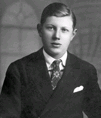E. Herbert Norman
This article needs additional citations for verification. (February 2013) |

Egerton Herbert Norman (September 1, 1909 – April 4, 1957) was a Canadian diplomat and historian.
Early life and education
Born and raised in Karuizawa, Japan to Canadian Methodist missionaries, he studied at Victoria College at the University of Toronto, and Trinity College at Cambridge University. He entered the graduate program in Japanese history at Harvard University in 1936, where he studied under Edwin O. Reischauer. He joined the Canadian foreign service in 1939 and earned his doctorate in 1940.
Foreign service
His first post was with the Canadian Legation in Tokyo. Following the attack on Pearl Harbor in December 1941, Norman was interned by the Japanese authorities and he was not repatriated to Canada until mid-1942, where he continued to work in the Department of External Affairs. During the Allied occupation of Japan after its defeat in the war, Norman served as a Canadian representative to the Supreme Commander of the Allied Powers (SCAP) administration and worked under the direction of Douglas MacArthur. He also became the first post-war president of the Asiatic Society of Japan. Alongside his diplomatic activities, Norman remained an active scholar and wrote a number of works on Japanese history, which are still highly regarded by many historians.
Controversy and suicide
Between 1950 and 1952, during the McCarthy Era, Norman was suspected of being a Communist and possibly a Soviet agent. Allegations centred on his involvement with various communist societies during his university years, and suspicion of various decisions he helped make during the Japanese occupation, including allowing the Japanese Communist Party to continue while other parties were banned. Norman was eventually exonerated but American diplomats remained wary of Norman's presence in the upper echelons of External Affairs. Norman was fiercely protected by Secretary of State for External Affairs Lester Pearson, a longtime friend. This created a variety of diplomatic conflicts with the U.S. Department of State, who refused to send sensitive information through Norman. Norman was eventually made High Commissioner to New Zealand, both to placate American authorities and to isolate him from the stress and scrutiny of American intelligence.
In 1957, these suspicions were revived in the United States Senate Subcommittee on Internal Security. In April of the same year he committed suicide in Cairo, where he had been serving as Canada's ambassador to Egypt, by jumping off the roof of the Swedish Embassy.[1] It was an eight-storey apartment building in which the Swedish Minister in Cairo occupied the top floor apartment. He left a brief suicide note asserting his innocence.[2] The Canadian public at the time was horrified, and the incident caused some harm to Canada-U.S. relations.
The circumstances surrounding Norman's death continue to provoke controversy. In 1990, Canadian Minister of External Affairs Joe Clark received a report written by Peyton Lyon that tried to exonerate Norman, sparking a debate with Professor James Barros who had authored a 1986 book detailing Norman's links to Communist groups. In 1994, Dr. John Howes suggested that Norman took his life because he was concerned that the Communist allegations could jeopardize the negotiations during the Suez Crisis.[3] Norman is buried in the Protestant cemetery in Rome.
Publications
- Norman, E. Herbert (1940). Japan's Emergence as a Modern State: Political and Economic Problems of the Meiji Period. International Secretariat, Institute of Pacific Relations.
- Norman, E. Herbert (1943). Soldier and Peasant in Japan: The Origins of Conscription. International Secretariat, Institute of Pacific Relations.
- Norman, E. Herbert (1949). Ando Shoeki and the Anatomy of Japanese Feudalism. Asiatic Society of Japan.
- Norman, E. Herbert (1975). Origins of the Modern Japanese State: Selected Writings of E. H. Norman. Random House, Inc.
References
- ^ Ferguson, William Stenner. "Why I Hate Canadians", 1997.
- ^ Knight, Amy (2005). How the Cold War Began. Toronto: McClelland & Stewart LMT. p. 266. ISBN 0-7710-9577-5.
- ^ John Howes (December 12, 1994). "Japan in Canadian Culture" (Document). Canadian Embassy, Tokyo, Japan: The Asiatic Society of Japan.
{{cite document}}: Unknown parameter|url=ignored (help)
Further reading
- Barros, James. No sense of evil : espionage, the case of Herbert Norman. Toronto: Deneau, 1986.
- Bowen, Roger W. Innocence Is Not Enough: The Life and Death of Herbert Norman. Vancouver: Douglas & McIntyre, 1986.
- M. Stanton Evans, "Blacklisted By History: The Untold Story of Senator Joe McCarthy and His Fight Against America's Enemies," (Three Rivers Press, New York, 2007).
- Maruyama Masao. "An Affection for the Lesser Names: An Appreciation of E. Herbert Norman (in Notes and Comment)." Pacific Affairs, September 1957, 249-53.
- Knight, Amy. "How the Cold War Began." Chapter 9 "Death of a Diplomat." New York: Carroll & Graf, 2005.
External links
- E. H. Norman Digital Archive
- Article by John Price, Japan Focus
- Short biography from the Herbert Norman Library
- Radio clip from CBC, April 4, 1957
- Feature from Canadian Mysteries
- The Man Who Might Have Been: An Inquiry into the Life and Death of Herbert Norman (1998 documentary film) at the National Film Board of Canada
- 1909 births
- 1957 deaths
- 20th-century Canadian historians
- Alumni of Trinity College, Cambridge
- Ambassadors of Canada to Egypt
- Burials in the Protestant Cemetery, Rome
- Canadian Japanologists
- Canadian male writers
- Diplomats who committed suicide
- Harvard University alumni
- High Commissioners of Canada to New Zealand
- Historians of Japan
- Historians who committed suicide
- Male suicides
- People from Nagano Prefecture
- People from Tokyo
- Suicides by jumping in Egypt
- University of Toronto alumni
- Victims of McCarthyism
